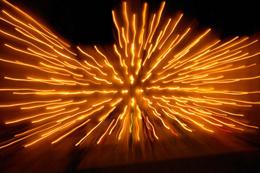Moving mirrors make light from nothing
Researchers claim to have produced sought-after quantum effect.
 A moving mirror can generate light from a vacuum.Phil M Rogers / Alamy
A moving mirror can generate light from a vacuum.Phil M Rogers / AlamyA team of physicists is claiming to have coaxed sparks from the vacuum of empty space1. If verified, the finding would be one of the most unusual experimental proofs of quantum mechanics in recent years and "a significant milestone", says John Pendry, a theoretical physicist at Imperial College London who was not involved in the study.
The researchers, based at the Chalmers University of Technology in Gothenburg, Sweden, will present their findings early next week at a workshop in Padua, Italy. They have already posted a paper on the popular pre-print server arXiv.org, but have declined to talk to reporters because the work has not yet been peer-reviewed. High-profile journals, including Nature, discourage researchers from talking to the press until their findings are ready for publication.
Nevertheless, scientists not directly connected with the group say that the result is impressive. "It is a major development," says Federico Capasso, an experimental physicist at Harvard University in Cambridge, Massachusetts, who has worked on similar quantum effects.
At the heart of the experiment is one of the weirdest, and most important, tenets of quantum mechanics: the principle that empty space is anything but. Quantum theory predicts that a vacuum is actually a writhing foam of particles flitting in and out of existence.
The existence of these particles is so fleeting that they are often described as virtual, yet they can have tangible effects. For example, if two mirrors are placed extremely close together, the kinds of virtual light particles, or photons, that can exist between them can be limited. The limit means that more virtual photons exist outside the mirrors than between them, creating a force that pushes the plates together. This 'Casimir force' is strong enough at short distances for scientists to physically measure it.
From virtual to real
For decades, theorists have predicted that a similar effect can be produced in a single mirror that is moving very quickly. According to theory, a mirror can absorb energy from virtual photons onto its surface and then re-emit that energy as real photons. The effect only works when the mirror is moving through a vacuum at nearly the speed of light — which is almost impossible for everyday mechanical devices.Per Delsing, a physicist at the Chalmers University of Technology, and his colleagues circumvented this problem using a piece of quantum electronics known as a superconducting quantum interference device (SQUID), which is extraordinarily sensitive to magnetic fields.
The result was a shower of microwave photons shaken loose from the vacuum, the team claims. The group's analysis shows that the frequency of the photons was roughly half the frequency at which they wiggled the mirror — as was predicted by quantum theory.
Capasso calls the experiment "very clever". He doubts that the effect has any practical use because it doesn't generate large numbers of photons, but he considers it a nice demonstration of quantum mechanics. He still hopes to see a moving piece of metal generate detectable light from the vacuum, and believes that micromechanical systems may eventually be able to reach such speeds.
Pendry says that the result, if it stands up, is bound to generate excitement. "Work in this area stirs considerable passion in the breasts of physicists."
Source
No comments:
Post a Comment